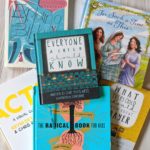
Frequently I have friends contact me with questions about getting started in cloth diapering. I will admit, it can be a little overwhelming to start researching cloth diapers! First of all, it’s really confusing when you start looking to buy cloth diapers. “OS AIOs with H&L!” Whaaat? So here’s a breakdown on what all of that means, as well as the scoop on what you really need, how much time it takes, and what my favorite kind of cloth diapers are.
One-Size vs. Sized Diapers
You have two options for sizing when it comes to cloth diapers. You can either buy sized diapers (x-small, small, medium, large), which your baby would wear for a period of time and outgrow (like how disposable diapers are sized). OR, you can buy one-size diapers (OS) which snap at various places on the diaper so that they will fit a baby newborn through potty training. I’m definitely on team One-Size, since I think it’s more economical to buy diapers your baby can wear the entire time. Plus, when you have two in cloth, like I do, they can wear the same diapers, just snapped to fit each girl when she needs it.
Hook & Loop vs. Snaps
You have two options when it comes to closures on diapers. Hook & Loop means Velcro(R) tabs and Snaps obviously mean snaps. There are advantages to both.
Velcro is very easy to fasten (especially on a wiggly baby) and is more similar to how disposables are fastened. Velcro also gives you a perfect fit around the waist since you can fasten it to exactly the right size. Velcro does tend to wear out faster than snaps, and the Velcro gets “gunked up” after a while and you have to clean it out so it will be “sticky” again. (You can use a pin to clean out the Velcro.) Also, smart babies (starting around 7-9 months for my girls) can figure out how to unfasten their diapers with Velcro.
Snaps also offer flexibility in sizing the waist, though not quite as much as Velcro. They are very durable and I’ve never had a snap fall off or get “loose.” They are harder for a baby to unfasten, though by 18 months Vera had figured those out too.
All In Ones vs. Pockets vs. Covers/Prefolds
All in Ones (AIOs) vs. Pockets are two of the most popular distinctions in types of diapers. Cloth diapers are made of two components: the outer shell of the diaper (which keeps the diaper from leaking), and the actual cloth diaper (which absorbs the wetness). All in One diapers have the cloth diaper insert attached to the diaper so you only have one total piece to deal with. Pocket diapers (what I use) consist of the outer shell (pocket) and liners (all sold together) that you stuff inside the outer shell before using. All in One diapers tend to be more expensive, since they are less work for you (these are pretty cool, if you go that route). I don’t mind stuffing/folding my pocket diapers, though. It literally takes me 10 minutes every 2 days to fold all of them. The other option you have is covers and prefolds. This is less popular now, but it’s how cloth diapering used to be done two generations ago. You would fold a cloth diaper (known as a prefold), fasten it (using a Snappi or pins), and put a cover over it to prevent leaks. I have some diapers like these and I used them early on with each baby (when I needed extra diapers), but they have never been my favorite type.
Okay… so that was a rundown on all the types! Now for my favorite kind.
I love Smartipants One Size Diapers. They are very affordable (it might seem expensive at first, but cloth diapering birth-potty training can save you $3,000 per child), and while I do love some other brands (like bumGenius), these are just as nice as those other brands but cheaper. They are made in the USA and the company has good customer service. The diapers snap down really tiny (I was able to use them with Cordelia starting at 3 weeks, though I don’t recommend doing that since she was still pooping like 14 times a day). The diapers also work on older children. Vera is wearing them just fine. They have snaps, which, like I said, hold up really well. They are pocket diapers so you do have to stuff the insert back inside after laundering them, but you don’t have to remove the insert before laundering (it just falls out in the wash and gets clean).
Besides cloth diapers, you will need a few other things:
-cloth diaper safe detergent (my top pick)
-a wet bag to store dirty cloth diapers in (my top pick: Planet Wise Large Wet Bag)
-a small wet bag for the diaper bag (mine is from etsy and was a gift, but some diaper bags come with a plastic pouch that works too)
-cloth wipes (can just be made from flannel receiving blankets you no longer use or cheap baby wash cloths) and (optional) a wipes solution (I like this one, but water works fine too)
-a drying rack for hanging the outsides of your diapers indoors (it is recommended that you dry the insides in the dryer and hang dry the outsides so the leg elastic won’t wear out as quickly) … you may already have one of these
-a few prefold diapers to use to stuff your diapers overnight (It is not uncommon for Vera to sleep 14 hours, so her diaper needs a little extra fluff! I like these in the infant size for stuffing)
-cloth diaper safe diaper rash cream since you cannot use regular diaper rash cream with cloth diapers or it ruins them (my top pick is available here)
Affordability
If you’re trying to find out if cloth diapering will be affordable for your family, here is a cost calculator that might help. We bought our cloth diapers using money people gave us as baby gifts, and we did receive a few cloth diapers as gifts from family.
How many will you need?
It depends. 🙂 We have 34 cloth diapers in rotation for two girls, and we wash every two days. We usually only use 26 of those every two days.
The Down & Dirty on Poop
Okay… so the part of this post you’ve been waiting for! Details on the “ick” factor. There are really three stages of baby poop, and two of them are easy, cloth diapers or not, and one is a little grosser. When a newborn is breastfed, the diapers can simply be tossed in the wet bag and then laundered, since there are no solids to dump. The second stage is when a baby is starting to eat solid foods. Some of these diapers can be quite nasty to dump, honestly. You have to shake solids into the toilet, and sometimes these diapers don’t shake very well. Some people purchase a diaper sprayer to aid in cleaning these diapers. We’ve lived without one, but some people swear by them. The third stage is when the poop gets a little more regular and solid. These diapers are very easy to just dump into the toilet.
Washing Routine
We put a new diaper on each girl and put them in bed, then we round up all the cloth diapers in the house (you know, the ones left in the diaper bag, etc.). That way, when we wash, we clean every diaper except the two that are currently being worn. We pre-wash on cold, wash on hot, and double rinse. Then we hang the outsides and tumble dry the insides. The next morning, I stuff all the inserts back inside and fold the diapers. Like I said, it takes me 10 minutes.
Sanitizing
It is important to sanitize your cloth diapers on a regular basis. Most diaper manufacturers recommend sanitizing your diapers with 1/4 cup of bleach in a regular load once a month.
If your diapers start to stink, you can “strip” them by using 1 Tbsp. of original Dawn blue dish detergent in a regular wash, rinsing until no longer sudsy. Of course, check with your cloth diaper manufacturer so you don’t void your warranty.
Both of these procedures should keep your diapers smelling like new!
If you have other questions about cloth diapering that this post didn’t answer, feel free to ask! I hope this info is helpful to you!
Do you cloth diaper? If yes, why? If not, why?









